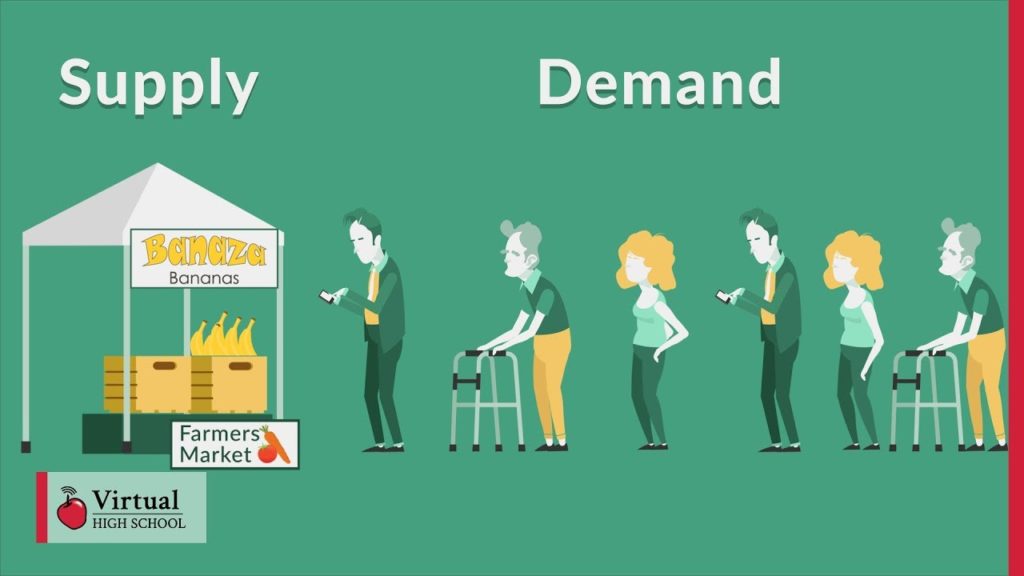In 5 minute, without being academic and nerdy, let’s use plain language to explain “supply and demand” and how it is applied in many real world situations.
How Does Supply and Demand Work?

We use a simplified economy to understand this. The economy consists of “bottled water” as the product, 4 consumers (a billionaire like Bill Gates, an affluent medical doctor, a plumber, and a homeless), and 4 producers (factory A, B, C, and D) that makes bottled water. We assume each consumer buys only 1 bottle if at all and each producer makes only 1 bottle if at all.
The billionaire is willing to buy a bottle of water for any price below $1m. The doctor, for any price below $10k. The plumber, for any price below $100. The homeless, for any price below $1. So when the price is between $1m and $10k, there is only 1 bottle of demand (the billionaire only). When the price is between $10k and $100, there are 2 bottles of demand (the billionaire and the doctor). When the price is between $100 and $1, there are 3 bottles of demand (the billionaire, doctor, and plumber). When the price is below $1, there are 4 bottles of demand (all 4 consumers). When we put these 4 data points on the diagram, we have the Demand Curve shown above.
The 4 producers have different appetite for making bottled water. When the price is below $1, only 1 factory (A) is willing to make, thus 1 bottle of supply. When the price is between $1 and $100, 2 factories (A and B) are willing to make, thus 2 bottles of supply. When the price is between $100 and $10k, 3 factories (A, B, and C) are willing to make, thus 3 bottles of supply. When the price is between $10k and $1m, 4 factories (A, B, C, and D) are willing to make, thus 4 bottles of supply. Basically, the higher the price, the more producers are attracted to make it. When we put these 4 data points on the diagram, we have the Supply Curve shown above.
From the diagram, $100 is a special price where the demand and supply curves meet. At this sweet spot, 2 bottles are produced and just 2 bottles will be sold. So it’s perfect match! However, the real world is never perfect. If the price starts above $100, say at $10k, 3 bottles will be produced but only 1 will be sold, so the remaining 2 bottles have to lower the price to sell, therefore the price moves lower towards $100. If the price starts below $100, say at $1, 1 bottle will be produced but 3 bottles are demanded. So in order to get the 1 bottle of water, the billionaire, doctor, and plumber will add price to compete for the water, so the price moves up towards $100. The price point of $100 is the equilibrium. The magic force of the market will always move the price and quantity towards this Equilibrium.
Where Can We Apply This?
This theory is not only for economist, but also super helpful for everyone during daily life. Believe it or not, if you apply the simple supply and demand model, you can answer all of these variety of questions:
- Why the housing price goes up? Why the housing price goes down?
- Why CEO’s make so much money?
- Why rent control doesn’t work?
- Why salary negotiation is so much harder for me than my friend?
- Why mortgage rate goes up and down?
- How can I get a big raise?
- How much room do I have during job offer salary negotiation?
- Why legalizing drugs is good?
- What causes inflation? Why inflation goes up and down?
- Who actually determines the daily gasoline price?
- What sports should I play in high school in order to get into Harvard? (Yeah, you heard this right!)
- And so on …
Often times the simplest fundamental principles are the most powerful ones that dictate how our world works. They are pervasive, so we take them for granted. They often appear so simple that we think we get it, however it’s not always the case. It’s worth time for everyone to dig a little deeper on this one, even if you are not an economist.
Were you able to answer all the above questions using supply and demand model? What other interesting questions were you able to answer using this model too? Please comment below.

